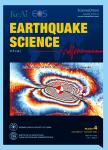Poroelastic finite-difference modeling for ultrasonic waves in digital porous cores
Poroelastic finite-difference modeling for ultrasonic waves in digital porous cores作者机构:Key Laboratory of Petroleum Resource ResearchInstitute of Geology and GeophysicsChinese Academy of Sciences Beijing North NewTech PetroTech Ltd Schlumberger WesternGecoHoustonTXUSA
出 版 物:《Earthquake Science》 (地震学报(英文版))
年 卷 期:2014年第27卷第3期
页 面:285-299页
学科分类:0709[理学-地质学] 0819[工学-矿业工程] 07[理学] 070801[理学-固体地球物理学] 0707[理学-海洋科学] 0818[工学-地质资源与地质工程] 0708[理学-地球物理学] 0815[工学-水利工程] 0816[工学-测绘科学与技术] 0813[工学-建筑学] 0825[工学-航空宇航科学与技术] 0704[理学-天文学] 0814[工学-土木工程]
基 金:supported by the National Natural Science Foundation of China (40925013) the Strategic Leading Science and Technology Programme (Class B) of the Chinese Academy of Sciences (Grant No.XDB10010400) the China National Major Science and Technology Project (2011ZX05023-005004)
主 题:Digital porous cores Ultrasonic coda Poroelastic finite-difference modeling Unsplitconvolutional PML absorbing boundary
摘 要:Scattering attenuation in short wavelengths has long been interesting to geophysicists. Ultrasonic coda waves, observed as the tail portion of ultrasonic wavetrains in laboratory ultrasonic measurements, are important for such studies where ultrasonic waves interact with smallscale random heterogeneities on a scale of micrometers, but often ignored as noises because of the contamination of boundary reflections from the side ends of a sample core. Numerical simulations with accurate absorbing boundary can provide insight into the effect of boundary reflections on coda waves in laboratory experiments. The simulation of wave propagation in digital and heterogeneous porous cores really challenges numerical techniques by digital image of poroelastic properties, numerical dispersion at high frequency and strong heterogeneity, and accurate absorbing boundary schemes at grazing incidence. To overcome these difficulties, we present a staggered-grid high-order finite-difference (FD) method of Biot's poroelastic equations, with an arbitrary even-order (2L) accuracy to simulate ultrasonic wave propagation in digital porous cores with strong heterogeneity. An unsplit convolutional perfectly matched layer (CPML) absorbing boundary, which improves conventional PML methods at grazing incidence with less memory and better computational efficiency, is employed in the simulation to investigate the influence of boundary reflections on ultra- sonic coda waves. Numerical experiments with saturated poroelastic media demonstrate that the 2L FD scheme with the CPML for ultrasonic wave propagation significantly improves stability conditions at strong heterogeneity and absorbing performance at grazing incidence. The boundary reflections from the artificial boundary surrounding the digital core decay fast with the increase of CPML thick- nesses, almost disappearing at the CPML thickness of 15 grids. Comparisons of the resulting ultrasonic coda Qsc values between the numerical and experimental



